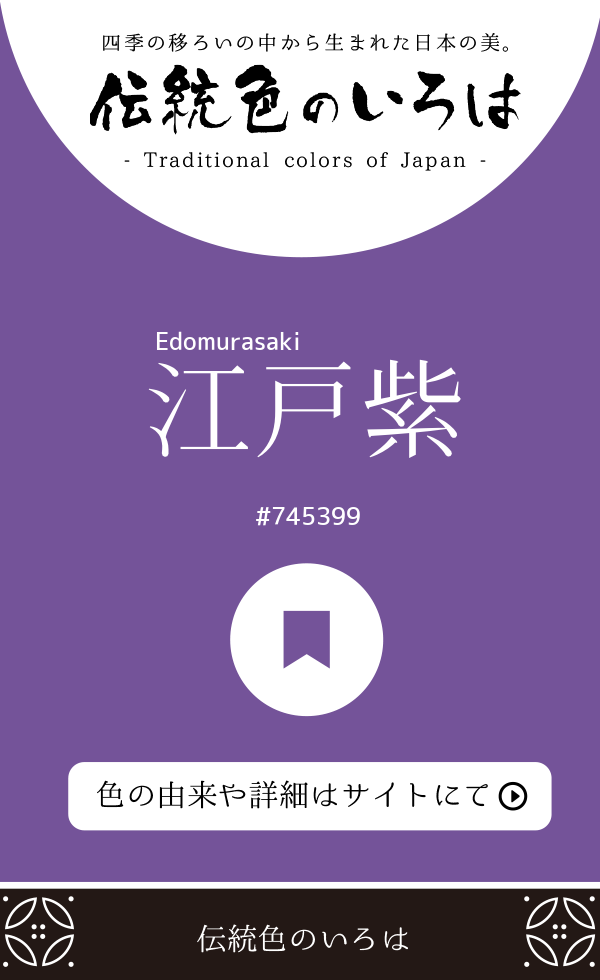| 色の名前Japan Color Name | 江戸紫(えどむらさき) |
|---|---|
| ローマ字Romanized | Edomurasaki |
| RGB | R:45 G:39 B:9 |
| CMYK | C:24 M:46 Y:00 K:40 |
| Web カラーHex triplet | |
| 誕辰色 | 3月23日 |
色の説明
江戸紫(えどむらさき)とは、桔梗の花の色に似た青みを帯びた紫のことです。名前の由来は、江戸で染められた紫の意で、代表例が歌舞伎の『助六由縁江戸桜 』で助六が頭に巻いている鉢巻の色があげられます。また、染名として『江戸染 』とも呼ばれ、俗称として『青紫 』『花紫 』と呼ばれることもありました。
名前の"江戸"には諸説があり、一つは、京都の「京鹿の子」に対する形で付けられたというものです。当時、紫染は江戸が優れ、紅染は京都が優れているとされ、「えどむらさき に 京鹿子」という言葉が示すように東西両都市の染色の特徴でした。
もう一つは、「京」の伝統的な紫である『京紫 』に対し、江戸の新しい感覚を取り入れた「江戸趣味の紫」の意で付けられたとするものです。いずれにしても江戸っ子の対抗心と個性が垣間見え、興味深いものがあります。
『江戸紫』の色合いは、さびた赤みをもつ『京紫』や『古代紫 』に対し、冴えた青みが特徴です。この新しい色合いが新しもの好きの江戸っ子に『今紫 』とも呼ばれ、広く親しまれました。
余談ですが、『江戸紫』は初期から色合いが変化しており、当初は『京紫』よりも赤みが強い色とされていました。江戸中期の旗本で有職故実家の伊勢貞丈 も著書「貞丈雑記 」で、「按紫色は今世京紫(青みの紫)と云色也、葡萄は今世江戸紫(赤みの紫)と云色也」と記し、『京紫』を青みの紫、『江戸紫』を赤みの紫と紹介しています。
しかし、後年の注釈で「京紫は赤気かちなり、江戸紫は青気かち也」と書き足しており、『江戸紫』が青みの強い色へと変化したことを示しています。この変化には、江戸前の色であった『藍』の青が『江戸紫』に影響を与え、江戸っ子好みの冴えた色合いに変化していったのかもしれません。
-読み:えどむらさき-
「江戸紫の鉢巻に髪は生締め、それて刷毛先の間から覗いて見ろ。
安房上総が浮世絵のように見えるわ」
『助六廓夜桜』歌舞伎。安永八年(一七七九)江戸・中村座初演。
関連する色の紹介
- ■紫(むらさき)の由来や色見本
- ■今紫(いまむらさき)の由来や色見本
- ■古代紫(こだいむらさき)の由来や色見本
- ■京紫(きょうむらさき)の由来や色見本
- ■青紫(あおむらさき)の由来や色見本
- ■花紫(はなむらさき)の由来や色見本
[Explanation of a color]
Edomurasaki (江戸紫) refers to a purplish color with a bluish hue, resembling the color of kikyo (balloon flower) blossoms. The name originates from the fact that it was a purple dye developed in Edo. A representative example is the headband worn by Sukeroku in the kabuki play Sukeroku Yukari no Edo Zakura (助六由縁江戸桜). It is also known by the dyeing name Edozome (江戸染) and was colloquially called Aomurasaki (青紫) or Hanamurasaki (花紫).
There are several theories regarding the inclusion of "Edo" in its name. One theory suggests that it was named to contrast with Kyoto's Kyokanoko (京鹿の子), as Edo was known for superior purple dyeing, while Kyoto excelled in red dyeing. This idea is encapsulated in the phrase "Edomurasaki ni Kyokanoko," symbolizing the unique characteristics of dyeing in the two cities.
Another theory posits that the name "Edo" reflects the incorporation of Edo's modern sensibilities into its purple dye, distinguishing it from Kyoto's traditional Kyomurasaki (京紫). Either way, the name conveys the pride and individuality of Edo residents.
The color Edomurasaki is characterized by its vivid bluish tint, in contrast to the subdued reddish tones of Kyomurasaki and Kodaimurasaki (古代紫). This distinctive hue appealed to Edo residents, earning it the affectionate nickname Imamurasaki (今紫), meaning "modern purple."
Interestingly, the shade of Edomurasaki has evolved over time. Initially, it was described as having a stronger reddish tint compared to Kyomurasaki. Ise Sadatake (伊勢貞丈), a hatamoto and scholar of ancient customs in the mid-Edo period, noted in his work Teijo Zakki (貞丈雑記): "The current Kyomurasaki is a bluish purple, while the current Edomurasaki is a reddish purple." Later annotations by the same author indicate a shift, stating, "Kyomurasaki has a reddish tint, while Edomurasaki has a bluish tint," suggesting that the color's characteristics changed over time.
This transformation may have been influenced by Edo's traditional indigo (ai) dye, which likely contributed to shaping Edomurasaki into the vivid, fresh hue favored by Edo residents.
-read:Edomurasaki-
参考文献
- 長崎盛輝『新版 日本の伝統色 その色名と色調』青幻舎 ISBN-10:4861520711
- 吉岡幸雄『日本の色辞典』紫紅社 ISBN-10:4879405493
- 内田 広由紀『定本 和の色事典』視覚デザイン研究所 ISBN-10:4881082035
注意事項
表示されている色(RGB値)は色の名前に対するおおよそものです。色名によっては広範囲の色を指す場合や文献・書籍等によっては解釈が異なる場合もありますのでご了承ください。 ご利用の環境によっては、色が適切に表示されていない場合があります。
印刷などに伝統色を利用したい場合は、DICグラフィックス株式会社から発売されている日本の伝統色シリーズがオススメです。
Pinterestでシェアする際にご利用ください。
サイト運営者からのお願い
このサイトが気に入った、役に立ったと思われた方は、Amazon・楽天で買い物をする際はぜひ下記のバナーをタップしてからお買い物をお願いいたします。
こちらからお買い物をしていただきますと、価格の1%相当のポイントがサイトに入ります。もちろんその分、高くなるようなことはありません。
いただいたポイントは今後のサイト運営のための書籍代や運営費、モチベーションにつながりますので、ご協力いただけますと嬉しいです。

 DIC 日本の伝統色 第9版
DIC 日本の伝統色 第9版



